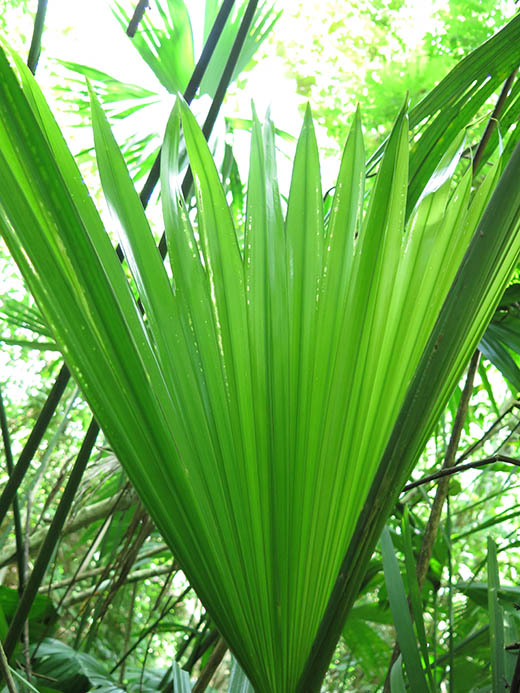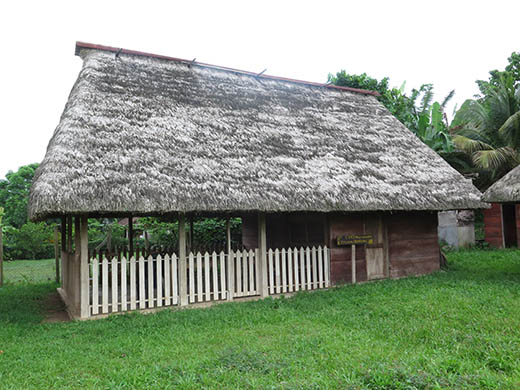What is used to thatch houses of the Mayan people?
For over 48 years I assumed that the normal material for thatch roofs of the Maya people was either guano or corozo (cohune, corozal) palm. Then I began to notice grass roofed houses while driving through portions of Alta Verapaz and Izabal. So this would suggest three kinds of thatching: two palm and one grass.
But the more you drive around, the more kinds of thatch you see. While on a weekend excursion to find and photograph waterfalls in rivers of Alta Verapaz, we spent the night in a most politely called rustic thatch roofed huts for visitors. The outhouse tried to be chic by using a modern latrine seat (one cup for urine; and adjacent space for #2). These “eco-friendly” latrines are the worst “pile of crap” that I have seen anywhere in the world. Plus they are the absolute most unhygienic toilets in the world. I find them harder to use than even squat-style toilets in Paris or villages in Iran or open troughs in China.
But when you pay $10 a night for your hotel room you get what you pay for (namely no toilets inside the room). Frankly most of the team preferred to go out in the bushes to relieve themselves.
But aside from the rural style of accomodations, what made this trip worthwhile was noticing that the roof was a palm other than huano. You can spell this either huano or guano. Downside is that guano is also the spelling for bat droppings.
 |
|
Junco palm thatch roofed house (exterior view). Taken with a Canon PowerShot G18, June 2014, Rio Ixbolay. Most Canon PowerShot cameras have quirks and we do not recommend them whatsoever.
|
The primary guano palm is common throughout El Peten, especially in the Tikal-Uaxactun-Lake Yaxha area (where I lived 1965 twelve months at Tikal, and 1970-1975 on the shores of Lake Yaxha, creating the Lake Yaxcha-Lake Sacnab national park). The best research on the guano palm tree is by ethnobotanist Dr Javier Caballero, UNAM. It would be nice if students and botanists could undertake comparable research on the corozal palm. It would be helpful if ethnobotanists could encourage students to undertake solid field work on the various grasses used as thatch. Plus a thesis and/or research project is needed on each and every one of the plants used for thatch besides guano palm, coroso palm, and aak grass.
The new guano palm has an edible core
The local Q’eqchi’ people were eating the hearts of palm even before I could photograph the tree.
 |
|
Carludovica Palmata Leaves, Taken with a Canon PowerShot G16, June 2014
|
Be aware that local names in Spanish tend to be imprecise
Junco is the local Spanish name given for Carludovica palmate. But Junco is also the local Spanish name for Bayal palm (Wilson 1972:369). Bayal is an incredible vine; it grows very high into the forest. Bayal has thorns; you peel them off and the core is used for cordage and making furniture. Bayal palm is also used to make wattle-and-daub walls for Maya houses.
Carludovica palmate is so totally different in size, shape, and everything else I am surprised to see the same Spanish word used for both this and Bayal. Junco is a palm TREE; bayal is a palm VINE.
List of plants used to thatch K’ekchi’ area Mayan houses
The new palm is not listed as being used for thatch in the K’ekchi’ ethnobotanical dissertation of Mike Wilson (1972). But ironically, otherwise, his list is longer than Lundell’s list of plants probably utilized by the Maya. He lists Carludovica palmata only as being used for weaving hats (1972:369). Our local Q’eqchi’ translator said this palm is used to weave hats in Honduras. Most web sites list it as the source for “Panama hats.”
Avena sativa L. (Wilson 1972:372)
Chamaedorea sp.?, family Palmae (Wilson 1972:393)
Dichromena radicans
Juncus marginatus var. setosus, family Juncaceae(Wilson 1972:393)
Juncus effusus var. solutus, family Juncaceae
Muhlenbergia macroura, family Poaceae (Wilson 1972:370)
Panicum sp.? (Wilson 1972:372-373)
Plus two or three other plants with no botanical name.
If you add the list of Wilson to the list of Lundell you get about 10 plants which can be used as roof thatch. If you add Belize and Yucatan, and then Copan, Honduras and areas of El Salvador, I would not be surprised if the total number of plants usable for thatch could be almost 20 plants. Because in a single field trip we already found a palm-like thatch type which rarely appears in discussions of Maya houses, Carludovica palmate.
Carludovica palmata is not a true palm. The seed pod looks (to me as a person with no formal botanical training whatsoever) like that of monstera vines.
The identifaction as Carludovica palmata is by Ilena Garcia, based on the palm core being edible and the flowers. But we have only snapshots: no studio photographs (the day was exhausting and with no shower or even wash basin in the village accomodations, we were a bit “unwashed” this day). But it sure was helpful that the village did have buildings set aside for visitors. And there was a place to order “huevos al gusto” for breakfast and dinner.
A complete list of thatching materials for the Mayan people
would be a helpful thesis or dissertation topic
Hopefully a student of architecture, of ethnobotany, or of anthropology will tackle “Maya Thatch Roofs” as a thesis or dissertation topic. Graffiti on temple and palace walls of Maya buildings show thatch roofed monumental structures, so 2000 years ago, thatch was also used for temples, palaces, and elite structures. In the meantime here is our preliminary tabulation. A linguist could improve on this greatly, but at least we can get this started (and I doubt many other sources get even as far as we are trying to do).
Don Chus knows the flora and fauna of most of Izabal and Alta Verapaz. He currently lives about 30 minutes drive from La Chua park.
|
Lundell |
Wilson PhD, |
Don Chus, |
|
|
Arecaceae |
|
|
|
tun k'im; ‘lying-down straw’; poor thatch |
|
|
|
boloc; sedge; Pokomchi’ thatch |
|
|
|
Juncaceae |
|
|
|
Juncus effusus var. solutus Fern.& Wiegand |
|
|
|
tam; tam |
|
|
|
|
|
|
|
pac'ac'; forage, thatch grass |
|
|
Imperata contracta (HBK.) Hitchc. Ac. |
aq / Öakak'; roofing thatch |
This column will be filled out shortly, especially ac. |
|
|
Poaceae: Muhlenbergia macroura |
|
|
|
šalab a:qam |
|
|
Sabal mayarum Bartlett. Botán, huano. |
|
|
|
Orbigya cohune (Mart.) Dahlgren. Tutz, corozo, cohune. |
|
|
|
Scheelea lundellii Kantutz, corozo. |
|
|
The above tabulation is for Izabal, Alta Verapaz, and El Peten, Guatemala. We would like to extend this to the Highlands (Guatemala and Mexico), to the Chorti area of Guatemala and adjacent Copan Ruinas area of Honduras and to Chiapas, Yucatan, Tabasco, etc. as there were Maya people building thatch roofs throughout many areas of Mesoamerica.
Javier Caballero has helpful information on Sabal genus of guano palms of the Yucatan penisula of Mexico (see our separate bibliography). All this information will be added to future tabulations.
Today thatch roofs are used for chic hotel suites, restaurants, and occasionally even for public buildings. It is always helpful when the local Maya milpa farmers do not slash-and-burn down any of the palm trees which can be used for thatch.
 |
|
Palm roffed house (exterior view), Taken with a Canon PowerShot G16, June 2014
|
Updated August 25, 2014.
First posted June 24, 2014































